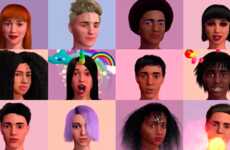
The 'Braille Emoticons' Project by Walda Verbaenen is Inclusive
Michael Hemsworth — November 26, 2021 — Lifestyle
References: walda.be & yankodesign
The 'Braille Emoticons' project has been developed by type designer and PhD student of the MAD School of Arts in Belgium Walda Verbaenen as an inclusive way for those with vision impairments to better understand and partake in digital culture.
The project proposes a total of 22 additional symbols or emojis that could be added to the Braille alphabet, which consists of everything from smily faces to thumbs up or down. The various characters are designed on the traditional 12 dot grid in order to make them fit in well with the existing alphabet.
The 'Braille Emoticons' project was explained further by Verbaenen who said, "People who use Braille are forced to use the letters of the alphabet to describe their emotions. This became a starting point to design an addition to the Braille alphabet, based on our visualized emotions into emoticons, converted into the ‘dot’ language that characterizes Braille."
The project proposes a total of 22 additional symbols or emojis that could be added to the Braille alphabet, which consists of everything from smily faces to thumbs up or down. The various characters are designed on the traditional 12 dot grid in order to make them fit in well with the existing alphabet.
The 'Braille Emoticons' project was explained further by Verbaenen who said, "People who use Braille are forced to use the letters of the alphabet to describe their emotions. This became a starting point to design an addition to the Braille alphabet, based on our visualized emotions into emoticons, converted into the ‘dot’ language that characterizes Braille."
Trend Themes
1. Inclusive Braille Emojis - The Braille Emoticons project creates an opportunity to expand the use of inclusive emojis in digital communication for individuals with visual impairments.
2. Accessible Digital Culture - The project highlights the potential for disruptive innovation in creating digital content and platforms that cater to the needs of the visually impaired community.
3. Combining Traditional and Digital Communication - The use of Braille in digital communication through the addition of emoticons paves the way for disruptive innovation in creating more hybrid forms of communication.
Industry Implications
1. Assistive Technology - The Braille Emoticons project is an innovation opportunity for assistive technology companies to create more accessible and inclusive digital solutions for individuals with visual impairments.
2. Digital Media and Communications - The project highlights an opportunity for the digital media and communications industry to create more accessible and inclusive content and platforms for those with visual impairments.
3. Design and Typography - The project opens up opportunities for the design and typography industries to create inclusive and accessible typography and Braille designs that cater to those with visual impairments.
1.5
Score
Popularity
Activity
Freshness























